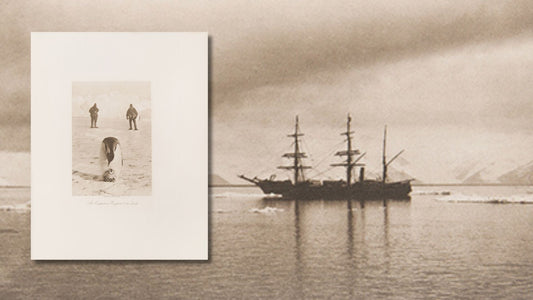A Journey Through Natural History

Welcome to TEFAF Maastricht: the fair that plays host to some of the most memorable treasures in the art world. With artworks that span over 7000 years, the event has an illustrious history, welcoming collectors and art loves alike for more than three decades.

Let’s visit our stand and explore the unique collection of prints, rare books and manuscripts, including a particularly fine selection of natural history works, which we have on show this year. Join us now on a tour of discovery as we view our carefully curated selection of items, now available at stand 228 at TEFAF Maastricht.
Stand 228
Take a moment to absorb the space: the walls in crimson red paint (inspired by HUGUENOT™ no. 49 by Mylands), the black-painted bookshelves, the café au lait carpet, with light gently flooding the walls, highlighting each rare item. Then close your eyes and listen to the hum of voices around you. We have arrived at TEFAF Maastricht.

To begin our tour, at the very entrance to the Shapero stand, let’s step over to the left, where we find a group of boldly coloured parrots from Mr. Gould’s Birds of Australia. The first four are cloaked in brilliant black ebony feathers with a splash of scarlet on their tail feathers. Beside them, in contrast, a group of white cockatoos, crowned with gold and swept with brilliant white, with others in pink and soft sober grey feathering. This striking flock are undoubtedly one of the finest ever examples of natural history illustration.
A selection of prints from The Birds of Australia, one of the most valuable and accomplished works by the ornithologist John Gould. Of the animals depicted in the work, the plates depicting cockatoos and parrots remain amongst the most astonishing.

Next, as we turn from the parrots we find a wall of 18th-century tulips, including some fine ‘parrot tulips’ no less. With tulips identified by Polly Nicholson, author of The Tulip Garden and holder of the National Collection of historic tulips, as variegated ‘bizarre’ tulips, ‘peony-flowered’ tulips and ‘vridiflora’ tulips, Weinmann’s flowers are a stunning sight alongside Gould’s parrots.
Johann Wilhelm WEINMANN. [A Group of Six Mezzotints of Tulips]. Regensburg, 1737-1745.

An apothecary by trade, Weinmann organised the production of these plates, which are realised using a form of the Mezzotint process, which combines the technique with etching to produce ‘delicate lines and a very fine grain’ while ‘[t]he addition of hand-tinting brought about unusual and subtle effects’ (Hunt).

For the next part of our tour we move to the rear of the Shapero stand where the black-painted bookcases rise to meet the ceiling. Here Edward Lear’s boldly drawn young macaw with scarlet, yellow and blue plumage stares out at us, with its head turned over its shoulder. Above the macaw, a trio of hummingbirds hover over the page of John Gould’s monograph, whilst below the red and russet trogons dance in the air.

Lear’s first published work, which also became the first work of illustrated ornithology entirely dedicated to a single family of birds. Includes 42 hand-coloured lithographed plates, heightened with gum arabic.

John GOULD. Monograph of the Trochilidae, or a family of humming birds. London, 1861.
John Gould’s monograph speaks to his passion for the animals and remains one of his most successful and popular texts, especially during his lifetime. Enhancing the work’s illustrations, Gould utilised a technique of applying paint over pure gold leaf to illustrate the hummingbird's iridescence.

John GOULD. A Monograph of the Trogonidae, or Family of Trogons. London, [1836-] 1838.
John Gould’s monograph on Trogons, including 36 hand-coloured lithographed plates by John and Elizabeth Gould, handsomely bound in nineteenth-century green morocco gilt by Clyde.
Turning to the right, we see a group of much-admired aloes, which have found their way onto the Instagram feed of numerous visitors, including the American Editor of World of Interiors. Poised bristling along the wall, their leaves twist to escape the confines of their containers, each of which is as individual as the aloes themselves.
Along with his tulips, Weinmann’s Aloes consist of one of the earliest examples of colour printing. A series of botanical Mezzotints, framed and glazed in handmade gold leaf frames.
Joachim Johann Nepomuk Anton SPALOWSKY. Beytrag zur Naturgeschichte der Vogel. Vienna, 1790-1795.
From here, we stroll along the wall of jewel boxes, containing the most precious items, including one of the most extraordinary pieces in our natural history collection. One of only three verifiably complete copies of Beytrag zur Naturgeschichte der Vogel which brings together some of the most stunning zoological illustrations of the 18th century. Elegantly arranged in their mirrored black case the four volumes display a crane feathered with cerulean blue. Sharp beaked, it dips to devour a worm, presenting its striking red crest to the fore of the page.
An astounding work, most likely produced specially for its owner Count Moritz Von Fries, then the richest man in the Habsburg empire. Undoubtedly the finest of the three complete copies, the work includes 8 watercolours and framings which are most likely unique.









